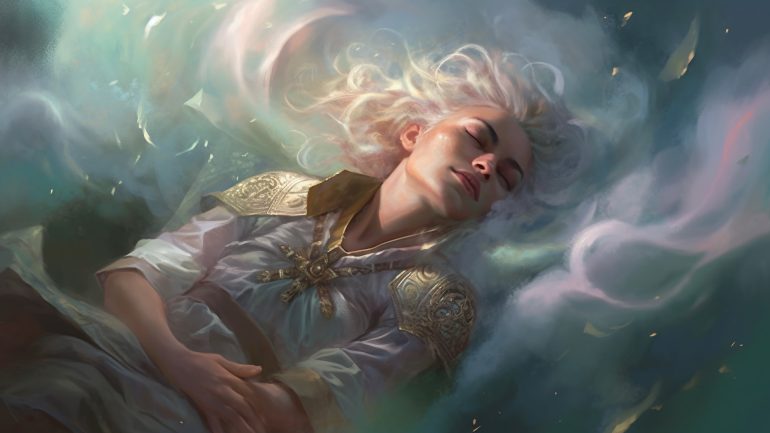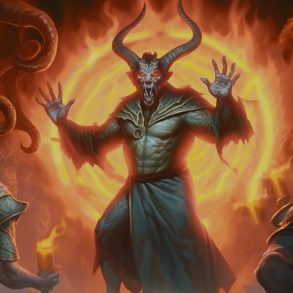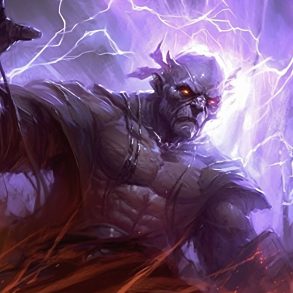What is Sleep 5E?
Sleep 5E (PHB, p. 276) is a 1st level enchantment spell, which is only natively available to Bards, Sorcerers, and Wizards. It requires a vocal, somatic, and material component, with the latter being a cricket, rose petals, or a pinch of fine sand. It takes an action to cast and has a range of 90 ft, affecting 20 ft. around a point you choose within that range. When the spell is cast you roll 5d8 to create a pool of hit points, each creature whose current hit points are fewer than this pool falls unconscious.
When deciding which creatures are affected, start with the lowest hit point total and deduct each affected creature’s HP from the pool before moving on. For example, if you are fighting 4 goblins with 7HP each and roll 21 when you cast Sleep, you will be able to knock three of them unconscious. A creature remains unconscious for 1 minute, until they take damage, or until another creature spends an action to wake the sleeping creature.
Creatures are unaffected by this spell if they are undead or immune to the charmed condition. Some creature-specific traits may also make a target immune to this spell, for example, elves cannot be put to sleep by magic due to their Fey Ancestry feature.
If you cast this spell with a 2nd level or higher spell slot, add 2d8 to the total you roll for the spell per each spell slot level above 1st.
Is Sleep 5E a good spell?
It’s a great spell in tier 1, where it can completely change the flow of an encounter and make an otherwise difficult fight, a breeze. However, it’s essential to coordinate with your party when you use this spell, to not only avoid catching them in the spell but to focus their attention. This is because the value of the spell is greatly reduced if your allies start attacking the creatures you just put to sleep without focusing on one at a time, you don’t really benefit enough to make it worth casting the spell.
As the levels increase the value of this spell will drop off significantly, however, you can still upcast it to maintain relevance or use it once the monster(s) in question have already been damaged. Regardless of upcasting, I wouldn’t recommend relying on this spell being effective if you get into tier 3 and beyond.
How can you get Sleep 5E spell?
If the idea of becoming the sandman interests you, then don’t worry! There’s a surprisingly long list of ways you can make a Metallica song your theme song:
- Bard, Sorcerer, Wizard – These classes get Sleep on their spell lists natively.
- Arcane Trickster (Rogue Subclass) – This Rogue can choose spells from the Wizard spell list, and can choose Sleep as one of their unrestricted spells as early as 3rd level.
- Eldritch Knight (Fighter Subclass) – Similar to above, this Fighter subclass can choose spells from the Wizard list and can choose Sleep as one of their spells as it matches their evocation restriction.
- Archfey (Warlock Subclass) – This Warlock patron allows you to choose Sleep as a Warlock spell from the Expanded Spell List feature.
- Oath of Redemption (Paladin Subclass) – These mostly pacifist Paladins always have Sleep prepared thanks to their Oath Spells.
- Twilight Domain (Cleric Subclass) – Twilight Clerics always have Sleep prepared as it is one of their Domain Spells.
- Pallid Elf (Race) – This Elf subrace can be found in Explorer’s Guide to Wildemount and can cast Sleep once per day for free as part of their Blessing of the Moon Weaver feature. The same feature also gives them the Light cantrip and a free casting of Invisibility once per day.
- Mark of Hospitality Halfling (Race Variant) – Any spellcasters that choose this race can choose Sleep as a spell thanks to the Spells of the Mark feature.
- Magic Initiate (Feat) – By choosing Bard, Sorcerer, or Wizard as the class spell list, you can choose Sleep as the spell you can cast once per day, along with two cantrips from the chosen list.
- Aberrant Dragonmark (Feat) – This half-feat allows you to bump your Constitution by +1, grab Sleep, and a cantrip of your choice from the Sorcerer spell list. Just be careful casting Sleep in case you accidentally hurt your allies, or worse, wake the targets of your Sleep!
- Fey Touched (Feat) – Besides grabbing Sleep and Misty Step, both of which you can cast once per long rest for free in addition to with spell slots, you can also increase your choice of Int, Wis, or Cha by +1.
- Strixhaven Initiate (Feat) – You can get a free casting of Sleep with this feat no matter which college you choose, as long as you choose the relevant spell list. In addition, you’ll also get two cantrips, the specifics depending on your choice of college.
How to roleplay the Sleep spell
Need some help roleplaying the Sleep spell? Here are some examples to help you out:
- As you chant the arcane words and wave your hands, a wave of soothing energy washes over your enemies. They start to look drowsy, their eyes growing heavy as they struggle to stay awake. One by one, they fall to the ground in a deep slumber, completely unconscious.
- You focus your mind and unleash a cloud of magical mist that envelops your foes. As they breathe in the mist, their eyelids grow heavy, and they start to nod off. Their weapons slip from their grasp as they slump to the ground, snoring softly.
- You whisper a lullaby, and the air around you starts to shimmer with a peaceful aura. Your enemies’ eyes droop, and they yawn uncontrollably, struggling to stay awake. Eventually, they succumb to the lullaby’s hypnotic effect and collapse into a deep sleep.
Hopefully, this article was informative and you didn’t need a friend to shake you awake at the end of it. if you’re interested in getting more bang for your buck from this spell, then check out our Sorcerer 5E guide, or If you’re interested in researching other spells then check out our 5E spells section, Good luck out there adventurers, until next time, try not to yawn!






